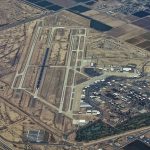In Mesa, a trainee pairs hands-on experience with education to chart a new career as a heavy equipment technician. In a Chandler classroom, community college students focus on the hottest health care jobs that will open the doors to the workforce. In Tempe, a seasoned professional transitions to a second career in fast-growing IT.
It’s a scene that plays out across the PHX East Valley region every day.
Dynamic education assets, strong workforce development opportunities and partnerships with business and industry are growing a uniquely talented workforce in the region. The efforts are critically important, helping fuel jobs of the future.

“Workforce development programs in Arizona are vital to the future of The Boeing Company’s business and the manufacturing sector in the state,” said Mark Gaspers, manager of government relations in Arizona.
Boeing needs a “pipeline” for a future workforce of engineers, scientists, mathematicians and highly-skilled employees to fill a range of positions.
“These jobs are critical to the survival and competitiveness of the aerospace and manufacturing industry across the state and the nation,” Gaspers said.
Dynamic Region
Endless opportunity, substantial growth, remarkable destination. That’s the PHX East Valley region in a snapshot.
The area comprises six vibrant communities with a young workforce – the average age is 35 – skilled in scientific, technical, healthcare and professional services fields. The area is also home to a rising tide of young entrepreneurs and innovative startups and small businesses.
Supported by a stable of educational institutions – from top-ranking Arizona State University to nationally-recognized East Valley Institute of Technology – the Phoenix East Valley region boasts a labor force of more than 800,000 workers.
Education and business leaders here understand that growing a diverse and in-demand talent pool is crucial for the future. Partnerships across the region are focused on strengthening the workforce, and address needs at all ages and stages.
A sampling shows the breadth of efforts:
STEM Education. Boeing focuses its community investments on building the 21st century workforce, said Mary Baldwin, Boeing’s Arizona community investor. The company supports myriad initiatives: early learning in math; STEM learning in Pre-K through 12th grades with hands-on experiential curriculum; career and technical education; and workforce transitions that have assisted more than 3,200 veterans. Boeing is also involved with a Technology Corridor initiative aimed at developing common manufacturing certification programs to quickly move students into manufacturing jobs statewide.
Automotive Careers. Mesa’s East Valley Institute of Technology and the Arizona Auto Dealers Association offer high school students hands-on training, job shadowing and internships at dealerships and repair shops to boost careers in the automotive industry. Today’s cars and trucks overwhelming rely on computerization, driving the need for a new workforce that can keep up with the new technology, said Mike McAfee, AADA’s director of education.
Thinking Big. Empire Southwest and Mesa Community College partner to increase the number of technicians trained to work on heavy equipment. The two-year ThinkBIG apprenticeship combines classroom and practical learning, with the opportunity to earn an Associate in Applied Science degree.
As baby boomers with technical skills retire, and less emphasis is put on pursing technical careers, the program is critical to meeting workforce demand, said Steve Utter, director of service operations at Empire. “We collectively as a society need to reframe how we view a technician or someone in a technical field,” he said.

On the Horizon
Maricopa Community Colleges – with multiple campuses in the PHX East Valley region – is one of the largest providers of job training in the state.
The district partners with hundreds of organizations in the public and private sectors for workforce development initiatives. Leveraging those relationships is critical to addressing workforce needs, said Dr. Randy Kimmens, associate vice chancellor of workforce development for the Maricopa County Community College District.
Identifying fast tracks into the workplace, a rallying cry of employers, and connecting employers and future employees through online platforms are equally important.
Experts say it will take both traditional education and technical training to fill high-demand jobs. Utter notes that of Empire Southwest’s 1600 employees, 600 are technicians. Each year, the company needs to fill roughly 60-70 of those technician jobs that are lost through attrition.
“There are not enough skilled people in the workforce,” he said.
Here is what Kimmens sees on the workforce horizon:
Manufacturing: Jobs in this sector are high value and high tech. Think robotics, nanotechnology, advanced machining, and artificial intelligence.
Healthcare: Allied health professionals – everything from dental hygienists to medical assistants to surgical technologists – are in demand.
Information technology: Jobs related to cyber security and the cloud lead the way here.
Advanced business services: Professionals in insurance, financial services, real estate and business management are tops on the list. The region’s diverse talent pool, workforce development opportunities, business friendly environment and stable climate all make the area appealing for this sector.




